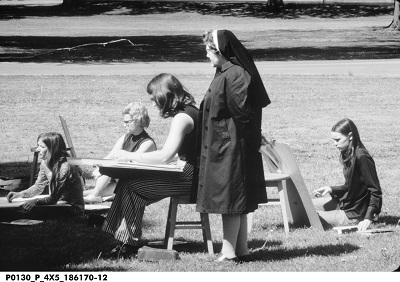
Plan your visit
Title IX: A Legacy of Access
Title IX: A Legacy of Access
Imagine not being able to take a class in engineering because you are a girl. Imagine being told that you have to use the teacher’s bathroom because of your gender identity. Imagine being told you’re fired because you’re pregnant.
One of the landmark wins for ending discrimination based on sex in our education system came with the signing of Title IX in 1972. Indiana’s own Senator Birch Bayh played a huge role in making sure this law came into existence so that girls had the same access to education as boys.
But Title IX has become bigger than this, protecting the rights of all students and staff regardless of sexual orientation, gender identity, nationality, immigration status, race or ability.
Title IX: A Legacy of Access is the Indiana Historical Society’s latest exhibit that explores how the law came into being as well as how it has shaped schools and universities all over Indiana.
Opening May 1 and running through July 31, 2021, the exhibit will be on display in the fourth floor Rosemary McKee Lanham Gallery.
The exhibit will focus on the way in which sustained activism by those in the women’s rights movement led to the passage of Title IX, how the legislation was championed by Senator Birch Bayh and Congresswoman Patsy Mink and others, and explore the impact the legislation has made, along with the debate it has sparked in the almost 50 years since its passage including in sports, protection against sexual harassment, and transgender rights.
The exhibit will feature several major topics surrounding Title IX, including:
Before Title IX:
Before Title IX, there was the Civil Rights Act of 1964 which prohibited discrimination on the basis of race, color, religion, sex or national origin with special provisions for the workplace, public accommodations, and federally funded programs.
While this act did cover discrimination based on sex, it was not comprehensive, and women continued to face bias in the workplace. This was especially true in schools as this act did not provide protections for employees or students at educational institutions.
The People Behind Title IX
Senator Birch Bayh, Congresswoman Edith Green, and Congresswoman Patsy Mink all played a major role in the creation of Title IX. Congresswomen Edith Green and Pasty Mink were responsible for introducing the amendment in the House, while Senator Bayh wrote the final version and brought it to the Senate.
Title IX and Education
Prior to the passage of Title IX, both male and female students were educated based on typical gender stereotypes. Girls were placed in home economics courses and encouraged to pursue careers as secretaries or nurses, while boys were encouraged to focus on science and math or shop classes. Title IX attempted to level the educational playing field for males and females and provide equal opportunity as well as protection for both sexes.
Title IX and Athletics
It was not until the late 1800s that women really began taking part in competitive sports and form athletic clubs. While there were some athletic activities available to women in the educational environment, sports were primarily relegated to intramural competitions. It was not until the end of World War II that intercollegiate competition for women’s athletics began to spread. By the early 1970s, women finally had the opportunity to compete in national competitions.
Challengers to Title IX
During the 1970s, Indiana’s five largest schools (Purdue, Notre Dame, Indiana State, Ball State, and Butler) spent more than $15 million a year on sports. With so much spending and potential revenue on the line, the implementation of Title IX as related to athletics was met with hostility. Educational institutions worried that in complying with Title IX by building up women’s athletic programs, schools would have to take away funding from their men’s athletic programs – particularly high revenue earning sports like football and basketball.








